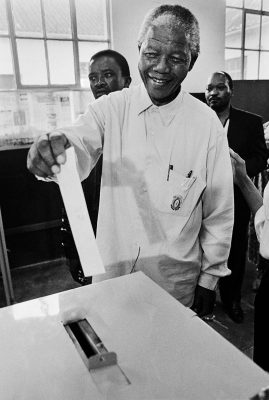It was a momentous day when Nelson Mandela became the first black president of South Africa. He had spent 27 years in prison for his fight against apartheid, and his election symbolized a new era for the country. As president, Mandela implemented many changes that improved the lives of South Africans.
Racial Reconciliation
His government focused on dismantling the legacy of apartheid by tackling institutionalized racism and fostering racial reconciliation. One of Mandela’s first actions as president was to sign into law the Promotion of National Unity and Reconciliation Act. This act granted amnesty to those who had committed political crimes during apartheid. It also created the Truth and Reconciliation Commission, which helped heal the wounds of the past by giving people a chance to tell their stories and be heard. In 1993, along with former President Frederik Willem de Klerk, he was awarded the Nobel Peace Prize for his efforts to end apartheid and promote reconciliation.
Education
Mandela once said, “Education is the most powerful weapon which you can use to change the world.” As a man who had contributed to significant change, he understood the importance of education in creating a better future. Under his leadership, South Africa made strides in improving access to education for all. The government built new schools and hired more teachers, focusing on rural areas that had been neglected during apartheid. The Mandela Institute for Education and Rural Development is one of his many legacies.
Before his election, only about 10% of black children could attend secondary school. During his presidency, the number of schools in South Africa doubled. He created a fund to provide financial assistance to students from disadvantaged backgrounds. He also worked to improve the quality of education by increasing funding for teacher training and school infrastructure. As a result, by the time he left office, over 80% of black children were able to attend secondary school.
As he wrote in his autobiography, A Long Walk to Freedom, “Education is the great engine of personal development. It is through education that the daughter of a peasant can become a doctor; that the son of a mine worker can become the head of the mine; that a child of farm workers can become the president of a great nation.”
Healthcare
Mandela also improved access to health care in South Africa. Before he was president, discrimination against black citizens meant that they received inadequate or no medical care. Even ambulance services were segregated. Under Mandela’s leadership, the government built new clinics and hospitals, especially in rural areas. The number of people with access to health care more than doubled. The infant mortality rate was halved, and life expectancy increased.
HIV/AIDS was a leading problem in South Africa during Mandela’s presidency. His son, Makgatho Mandela, died of AIDS in 2005. He worked to raise awareness about the disease and provide treatment and support to those affected. He also worked to break the stigma around the illness, which was often seen as a death sentence. Thanks to his efforts, more people were able to get treatment and support.
In 2003, Mandela launched the 46664 campaign to raise awareness about AIDS. The effort, named after Nelson Mandela’s prison number, utilized art and music to promote its message. It hosted concerts and events with some of the world’s most famous musicians, including Bono, Beyoncé, and Queen.
Economic Development
Under Mandela’s leadership, South Africa experienced significant economic growth. He worked to attract foreign investment and create jobs. He also reduced government spending and inflation. Before his administration, inflation was at 14% and fell to 5%. Interest rates dropped from 16% to under 9% within ten years of the ANC administration. The result was a more stable economy and improved living standards for the people of South Africa. It did not become the best economy in the world, but it was better than what it had been.
Mandela also worked to improve relations with other countries. Export-import trade increased during his presidency, and he worked to attract foreign investment. Finally, Mandela made it a priority to improve living conditions for all South Africans. He created new laws that gave people access to water and electricity and launched programs to build houses for those who did not have homes. He created jobs by investing in infrastructure projects like roads and bridges.
Under Mandela’s leadership, South Africa underwent several economic reforms. One of the most significant was the establishment of the Reconstruction and Development Programme (RDP). The RDP focused on creating jobs, improving housing, and providing basic services like water and electricity. The RDP successfully reduced poverty and improved millions of people’s living conditions.
Conclusion
Nelson Mandela’s election as president marked a new era for South Africa. He worked tirelessly to improve living conditions for all South Africans, regardless of race. Thanks to his efforts, more children could attend school, people had access to basic necessities like water and electricity, many found employment, and more people gained access to healthcare. Nelson Mandela’s legacy is one of hope and progress.
